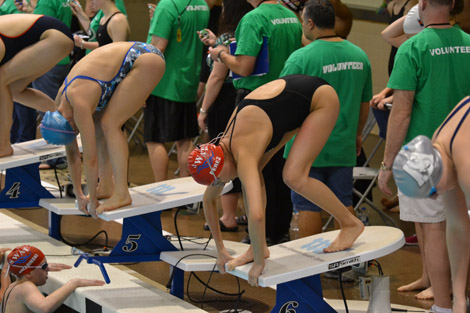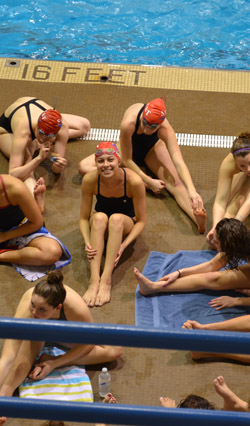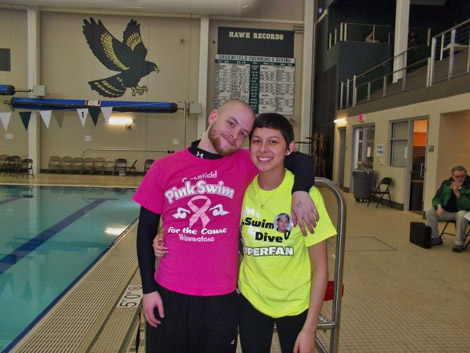I Always Knew Good Would Come From Swimming: Swim Star Battles Cancer
Feature by Shoshanna Rutemiller
PHOENIX, Arizona, February 20. NEXT month, Esmeralda Perez finds out whether the port in her chest can be removed. When the high school senior was diagnosed with Hodgkin's Lymphoma last year, the first thing that crossed her mind was not her personal health; it was her ability to continue doing what she loved.
“I was afraid that I wouldn't be able to swim,” she told Swimming World.
Perez has spent most of her life in the water. She was enrolled in swim lessons at age three after her mother noticed her daughter's aversion to water during bath time.
“I wouldn't put my face in the water.”
Fear turned into love, and lessons turned into competitive swimming. At age 12, Perez joined the South West Aquatic Team (SWAT) near Greenfield, Wis.
“I moved up the groups very fast. Before I even knew what a state cut was I got my 50 fly long course cut.”
Perez was rapidly improving. In 2009, as a freshman at Greenfield High School, she claimed half of the school records, qualified for the high school state meet, and was named MVP of the swim and dive team.
Then, her junior year, Perez noticed a change. “I was getting slower and fatigued. I was tired all the time and had very little energy at practice. My parents thought I was getting lazy, and I thought I was just stressed from school.”
Her fatigue began to affect her swimming performance. “I couldn't make the intervals and I added tons of time at meets. I would have horrible stomachaches.”

Eventually, Perez scheduled an appointment with her doctor to figure out the cause of her fatigue. “They thought I had low iron,” she said. But the butterflier's condition continued to worsen. “It eventually got so that I couldn't finish a 200 fly.”
Then something frightening happened in April 2012. “I found a lump in my neck just above my collarbone.”
Her doctor prescribed anti-inflammatory medication hoping the lump would reduce in size. There was no noticeable change. Perez visited an ear, nose, throat (ENT) doctor, who suggested a biopsy. After several tests, Perez finally had her answer: she had Hodgkin's Lymphoma.
Hodgkin's Lymphoma is a type of cancer that originates in the white blood cells (lymphocytes), and primarily targets the lymph node. It is most prevalent in people aged 15-35 or over 55.
Shortly after the diagnosis, Perez faced another disturbing revelation: the Lymphoma that started as a cancerous lump in her neck had spread downward and manifested itself in her chest.
“The doctor kept asking if I could breathe OK, because it was all the way down in my lungs. I guess that could explain why I wasn't swimming well.”
Treatment options for Hodgkin's Lymphoma include radiation therapy, chemotherapy or hematopoietic stem cell transplantation: transfusing a patient with stem cells typically derived from bone marrow.
“I was so terrified. I knew nothing about cancer but I knew treatments were horrible.”
Doctors explained the treatment options to Perez, suggesting that to easily deliver chemotherapy, she should either get an infusion line in her arm or a port surgically implanted in her chest. For Perez, the choice came down to one condition: which option was more viable for swimming?
“They said [with the line] I would need to be able to be careful about getting water in it in the shower, so I knew that wouldn't work for swimming.”
So she chose to have a port implanted into her chest. Perez described it as a plastic ring (about the size of a quarter) filled with a gel-like substance. By injecting the chemotherapy cocktail through the gel, doctors can easily deliver treatment.
“It hurt so bad after they put it,” she said. “Driving home I could just feel every bump in the road.”
Perez needed assistance anytime she moved around the house the days following her surgery. But even with a toxic cocktail of chemicals coursing through her veins, Perez' thoughts remained on swimming.
“I knew that recruiters would start recruiting for early signing, and I always wanted to swim out of state.”
So, she found a way to balance swimming with her chemotherapy.
Perez would go to the Children's Hospital to receive chemo every other Thursday, rest over the weekend, and then attend swim practice the following Monday. She continued this cycle of treatment, rest, and training for three month, giving up the summer vacation before her senior year.
“[Swimming] helped me get out of bed.”

Chemotherapy can make a patient's joints stiff and painful when the treatment enters the bone marrow. Perez feels that swimming helped loosen her joints, actually making treatment easier. When that wasn't enough, she turned to her teammates for support.
“They would say to me: you're a 200 flier, you can get through this! Nothing's worse than the 200 fly!”
Her teammates ran a donation bake sale to raise money for Perez's treatment, and even surprised her with a Relay for Life event.
“They kept that secret for months.”
Perez's cancer reduced by half after her first round of treatment. The doctors increased the toxicity for her second round, hoping for a benign reading at her next cancer screen.
“The second round of chemo made me sick,” she said. And the cancer remained. Instead of removing her port in August 2012, as promised, the doctors chose to keep it in indefinitely.
Even with the setbacks during treatment, Perez kept her sights on collegiate swimming. She hoped to swim on scholarship for a Division I school before her Lymphoma diagnosis; instead, she scoped out a number of Division II programs and took two recruiting trips in Colorado and Florida.
“They were both really fun, but the scholarships were very little and tuition would still be too expensive.”
So Perez continued her search. She visited Carthage College, a Division III school in Kenosha, Wisc., and fell in love with the school and the team. As an added bonus, she qualified for a tuition exchange because of her mother's employment.
“I always thought I would swim on a DI school, but the DIII team is so dedicated.”
January 4, 2013 was the last time Perez was screened for cancer. The tests looked promising, and the doctors will decide if the port can finally be removed from her chest this coming March.
“Yeah, I'm definitely nervous.”
Perez keeps the scarier outcomes that could result from her upcoming checkup out of her mind, instead choosing to remain optimistic about her freshman year of college and swimming for an NCAA university in the fall.
“I am most definitely still swimming. I know I still haven't reached my greatest potential yet, [and] I plan to strive for my full and greatest potential.”
She's traveled a rocky road, and continues on her journey. Perez is thankful for swimming in more than one way: the practices that got her out of bed everyday, the support from her teammates, and the physical strength the sport gave her prior to the diagnosis. Swimming gave her the ability to push forward when others could hardly comprehend the hardships she was facing as a 17-year-old girl.
“I always knew that something good would come from swimming.”
Read Part Two of Esmerelda's Story here

Photo Credit: Michelle Beiermeister



